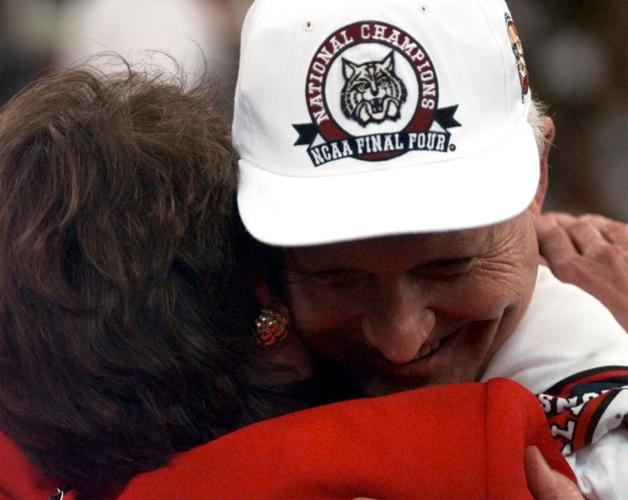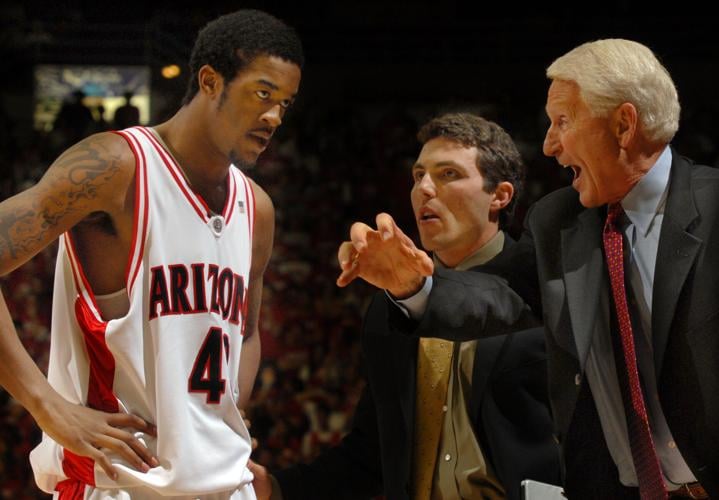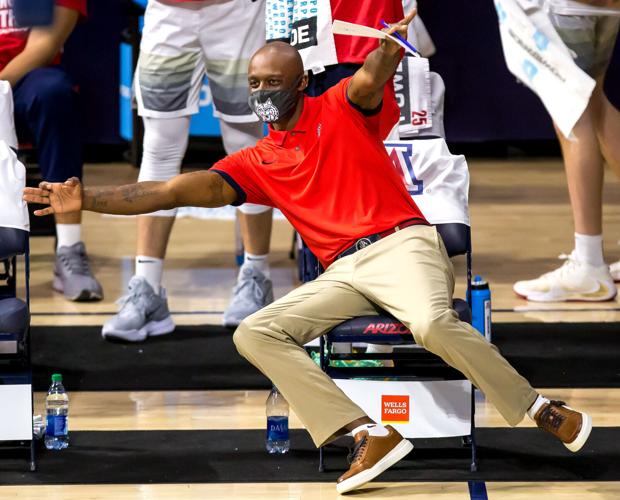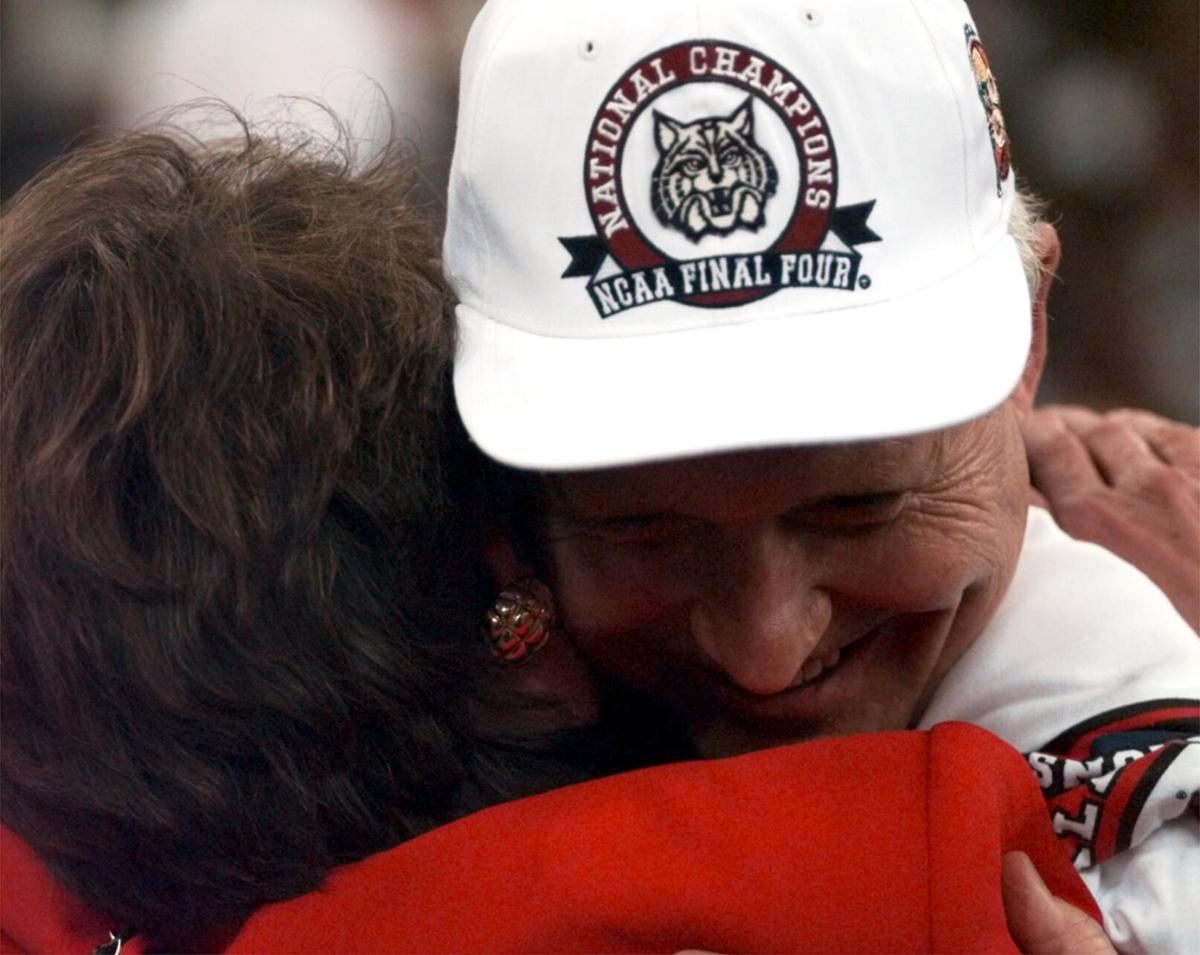Editor’s note: Today marks the 25th anniversary of Arizona’s 1997 national championship win over Kentucky in men’s basketball.
Lute Olson’s coaching tree has more branches than Bank of America.
There are former assistants like Jay John and Rodney Tention, who left Arizona for head coaching positions of their own.
There are too many former players to count, Steve Kerr and Joseph Blair and Damon Stoudamire among them.
Heck, even Olson’s own grandchildren — long-time Phoenix Mercury assistant coach Julie Brase Hairgrove and her brother, Portland Trail Blazers assistant Matt Brase — became prominent basketball coaches.
But Arizona’s 1997 national championship team was like a Silicon Valley incubator of coaching talent, with two current NBA G-League coaches, a long-time college head coach, a three-time state champion coach at his alma mater, and a CIF-championship-winning walk-on who was just named San Diego Union-Tribune boys basketball coach of the year.
Twenty-five years after they teamed up to win a national title, several of the branches on that vaunted coaching tree talked about what it was like to learn under Lute, and what that title run taught them.

Former UA walk-on Josh Pastner, middle, coached alongside Lute Olson before becoming the head coach at both Memphis and Georgia Tech.
Even-keeled Olson
If anyone on the ’97 squad was penciled in for coaching success, it was Josh Pastner.
A freshman walk-on on the ‘97 team who made an instant splash in the locker room, Pastner’s relentless positivity translated throughout the team. He’d go on to play four years for the Wildcat, serve as a graduate assistant and then a six-year assistant for Olson before becoming one of the game’s youngest head coaches at Memphis at the age of 31.
In so many ways, gosh darn it, he learned directly from Olson, who died in 2020 at age 85.
“I don’t curse, at all, and I don’t let any of my staff use any profanity. I don’t allow my players to use profanity, because I saw that with Coach Olson, too,” he said. “You can be successful without using foul language. How organized he was, how demanding he was in the standard he set forth on everything in the program. It all translated to why he was so successful. There was never a lowering of the standards.”
Forget cursing — Jason Terry rarely remembers Olson raising his voice.
“For me, it was more the tone he used,” said Terry, in his first season leading the Grand Rapids Gold of the NBA’s G-League. “He wasn’t a big screamer. To get your attention, he’d say your name long and drawn out. He’d always say, “Donnnnnnellllllll.” He added so many extra syllables. I find myself doing that from time to time.”
Even after losses, Olson found a way to remain even-keeled.
“One thing I learned from Lute is that he was usually more positive after losses,” Miles Simon, now the head coach of the G-League’s South Bay Lakers, told the Star in 2016. “I learned this when I coached under him. Because the team was already down. We already lost the game. He was harder on teams after we won, to keep everything even-keel.”
Arizona’s 1997 squad credits Olson’s steady hand with keeping them focused during the championship run, which saw them play six different schools with six different styles.
“He is — was — a very smart coach,” said longtime assistant Jim Rosborough, whom Olson hired as a graduate assistant coach at Iowa in 1974 and who later assisted Olson for nearly two decades with the Wildcats. “He learned a lot from watching John Wooden. He was very big on even preparation. You don’t get high for UCLA and low for Washington State. You don’t want your kids freaking out. Everything was kept as near to normal as possible.
“We tried to eat the meals at the same time. If you get the kids hacked up and everyone’s going nuts, that’s no good. You want everything just how it’s been. I don’t recall anything even different at all.”

Jason Terry coached under Sean Miller before leaving the UA to become head coach of the G League’s Grand Rapids Gold.
‘Excellence is not accidental’
Arizona wasn’t just steady during the ’97 run.
Seven Pac-10 Coach of the Year awards and 11 conference titles. Twenty straight 20 win-seasons, and 23 straight NCAA Tournament bids. No. 2 highest winning percentage in conference history and four Final Four appearances.
That is not a passing fancy, even if the Wildcats did some fancy passing during his tenure.
Maybe not too fancy, though.
“Everything was about discipline, and coach was as disciplined as they came,” Pastner said. “His discipline and the attention to detail — excellence is not accidental. The level of success he had, you can’t do that by being lucky. It was a long time of discipline, of doing it the right way, and of holding those standards to the level of what he demanded.”
Those standards were set early in the recruiting process, from the moment Olson step foot in a prospect’s town.
“Coach put a lot of weight on character, and I don’t think coaches do that as much anymore,” said Jason Stewart, who walked on to the Wildcats and just guided San Dieguito Academy to its first CIF-San Diego Section championship in almost 60 years. “If he’s recruiting you, he’ll go down to the local gas station, grocery store, and ask, ‘Have you seen this kid in here?’ And he’ll talk to the cashier. We live in an era now where people don’t care about that, or they look past character.”
And once he brought a player on campus, nothing changed.
He let players be themselves, and he let them learn.
He trusted them to be good, and they usually were.
“It was more about his ability to not micromanage us, to let our experience be the experience,” Terry said. “You have to go through it to understand it, he said. He couldn’t tell you. He had to let you show yourself. He had to let you experience failure and defeat, or even success. That willingness to let us fail or succeed was what made us.”
And in some ways, Pastner said, he helped make Tucson, too.
“He may be the one person who single-handedly helped put a team, a university and a city on the map,” Pastner said. “People have built programs, but I don’t know how many who built a city from the ground up.”
Photos: Arizona vs. Kentucky in the 1997 NCAA Championship Game
Kentucky vs. Arizona
Updated
Arizona's A.J. Bramlett and Bennett Davison hug after winning in overtime against Kentucky at the 1997 NCAA College Basketball Championship game in Indianapolis, IN.
Kentucky vs. Arizona
Updated
Arizona's Ooh Ahh Man, Joe Cavaler, leads a chant at the team hotel before the 1997 NCAA College Basketball Championship game in Indianapolis, IN.
Kentucky vs. Arizona
Updated
A University of Arizona cheerleader during a pep rally at the team hotel before the 1997 NCAA College Basketball Championship game in Indianapolis, IN.
Kentucky vs. Arizona
Updated
Matt Meliker gives the we are number one sign as UA fans fill the RCA Dome during the 1997 NCAA College Basketball Championship game in Indianapolis, IN.
Kentucky vs. Arizona
Updated
UA players gather outside their locker room before the 1997 NCAA College Basketball Championship game in Indianapolis, IN.
Kentucky vs. Arizona
Updated
Arizona's Miles Simon looks to pass under the pressure of Kentucky's Scott Padgett and Cameron Mills during the 1997 NCAA College Basketball Championship game in Indianapolis, IN.
Kentucky vs. Arizona
Updated
UA guard Mike Bibby is bringing the ball up the court with Kentucky player Ron Mercer during the 1997 NCAA College Basketball Championship game in Indianapolis, IN.
Kentucky vs. Arizona
Updated
Mike Bibby gets instructions from coach Lute Olson during the 1997 NCAA College Basketball Championship game in Indianapolis, IN.
Kentucky vs. Arizona
Updated
Kentucky coach Rick Pitino with Jared Prickettduring the 1997 NCAA College Basketball Championship game in Indianapolis, IN.
Kentucky vs. Arizona
Updated
Donnell Harris (left) holds onto Miles Simon as the clock winds down in overtime to give the Arizona their first NCAA Division I basketball title in the championship game against Kentucky in Indianapolis.
Kentucky vs. Arizona
Updated
Kentucky coach Rick Pitino hugs Nazr Mohammed during the 1997 NCAA College Basketball Championship game in Indianapolis, IN.
Kentucky vs. Arizona
Updated
UA Coach Lute Olson coaches players against Kentucky. during the 1997 NCAA College Basketball Championship game in Indianapolis, IN.
Kentucky vs. Arizona
Updated
Arizona's Josh Pastner runs out on the court to greet the team after a timeout was called during the 1997 NCAA College Basketball Championship game in Indianapolis, IN.
Kentucky vs. Arizona
Updated
rizona's Donnell Harris drives through Kentucky's Nazr Mohammed, left, and Jared Prickett during the 1997 NCAA College Basketball Championship game in Indianapolis, IN.
Kentucky vs. Arizona
Updated
Nazr Mohammed battles Arizona's Eugene Edgerson for a rebound during the 1997 NCAA College Basketball Championship game in Indianapolis, IN.
Kentucky vs. Arizona
Updated
Arizona's Donnell Harris tries to plow through Kentucky's Ron Mercer (left) and Anthony Epps (right) the 1997 NCAA College Basketball Championship game in Indianapolis, IN.
Kentucky vs. Arizona
Updated
Michael Dickerson brings the ball upcourt against Anthony Epps during the 1997 NCAA College Basketball Championship game in Indianapolis, IN.
Kentucky vs. Arizona
Updated
Arizona's Mike Bibby dishes off during the 1997 NCAA College Basketball Championship game in Indianapolis, IN.
Kentucky vs. Arizona
Updated
he Arizona bench explodes with joy as the end nears during the 1997 NCAA College Basketball Championship game in Indianapolis, IN.
Kentucky vs. Arizona
Updated
Arizona fans display their colors during the championship game against Kentucky during the 1997 NCAA College Basketball Championship game in Indianapolis, IN.
Kentucky vs. Arizona
Updated
Arizona players leap from the bench during the end of the second half against Kentucky during the 1997 NCAA College Basketball Championship game in Indianapolis, IN. Players from left to right are: Quynn Tebbs, John Ash, Josh Pastner, Jason Lee, Coach Lute Olson, Michael Edgerson, A.J. Bramlett, and Miles Simon. Assistant coach Jessie Evans is at far right.
Kentucky vs. Arizona
Updated
Mike Bibby cuts down the net after the Wildcats defeated Kentucky at the 1997 NCAA College Basketball Championship game in Indianapolis, IN.
Kentucky vs. Arizona
Updated
Arizona's Miles Simon and Mike Bibby get a ride following their victory over Kentucky at the 1997 NCAA College Basketball Championship game in Indianapolis, IN.
Kentucky vs. Arizona
Updated
Steve Kerr, the Arizona guard that led 1988 Final Four team and current coach of the Golden State Warriors, hugs Arizona head coach Lute Olson after Arizona won the 1997 NCAA College Basketball Championship game in Indianapolis, IN.
Kentucky vs. Arizona
Updated
Steve Kerr, the Arizona guard that led 1988 Final Four team and current coach of the Golden State Warriors, hugs Arizona head coach Lute Olson after Arizona won the 1997 NCAA College Basketball Championship game in Indianapolis, IN.
Kentucky vs. Arizona
Updated
Arizona head coach talks to the crowd as player Bennett Davison waves a towel after winning the 1997 NCAA College Basketball Championship game in Indianapolis, IN.
Kentucky vs. Arizona
Updated
Arizona players A.J. Bramlett and Miles Simon embrace after winning the 1997 NCAA College Basketball Championship game in Indianapolis, IN.
Kentucky vs. Arizona
Updated
Arizona head coach Lute Olson waves to the crowd after the team won the 1997 NCAA College Basketball Championship game in Indianapolis, IN.
Kentucky vs. Arizona
Updated
Arizona head coach Lute Olson during an appearance on the Today Show after the 1997 NCAA College Basketball Championship game in Indianapolis, IN.
Arizona Wildcats win NCAA championship
Updated
Lute Olson and wife, Bobbi, wave to fans while leaving the court after the Wildcats won the national championship in Indianapolis on March 31, 1997.







